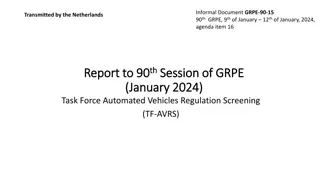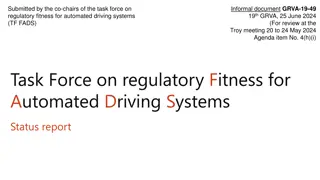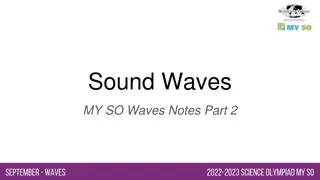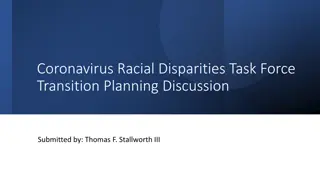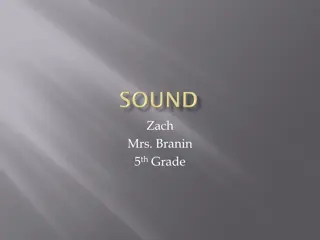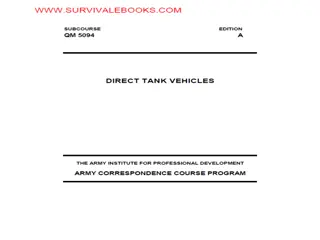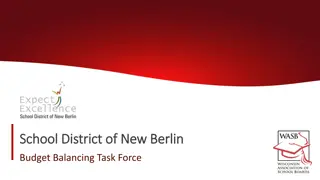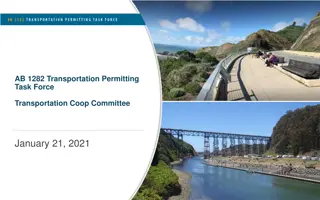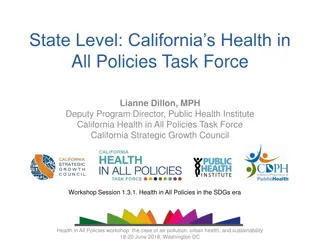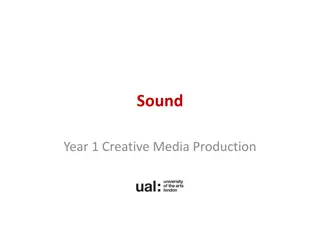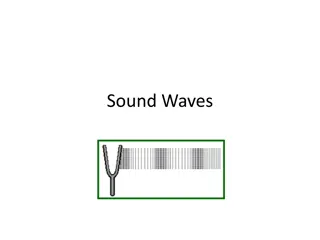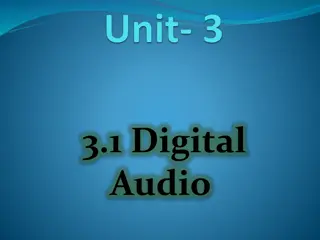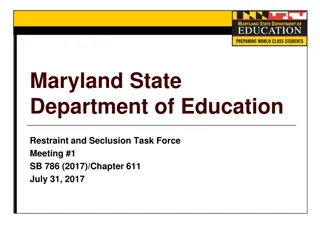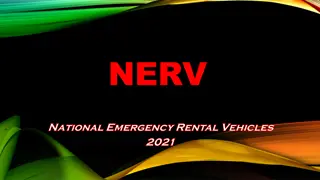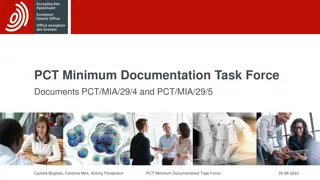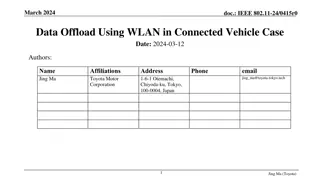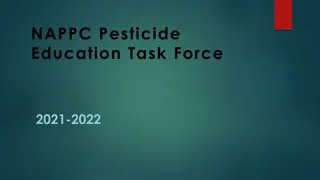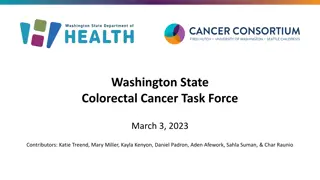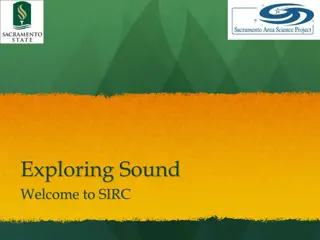Task Force Vehicles Sound: Status Report and Key Points
The Task Force Vehicles Sound (TF-VS) has been actively addressing sound level limits for regulations related to vehicle sound. Key points from experts' studies and meetings are covered, including the establishment of the task force, participants, meetings held, and ongoing work on drafting proposals and guidelines. The TF focuses on updating guidelines to encompass future activities and identifying noise issues efficiently.
Download Presentation

Please find below an Image/Link to download the presentation.
The content on the website is provided AS IS for your information and personal use only. It may not be sold, licensed, or shared on other websites without obtaining consent from the author. Download presentation by click this link. If you encounter any issues during the download, it is possible that the publisher has removed the file from their server.
E N D
Presentation Transcript
Informal Document GRBP-79-40 79thGRBP, 6-9 February 2024 Transmitted by the chair of the TF-SL (Sound Limits)/VS (Vehicles Sound) Agenda item 13 Status report to the 79 Status report to the 79th thsession of GRBP (February 2024) (February 2024) session of GRBP Task Force Vehicles Sound (TF-VS) NB: previous name of this TF was TF-SL for Sound Limits 1
TF Vehicles Sound: Key Points The experts from EC, ETRTO and OICA reported on their studies on sound level limits (GRBP-73-23, GRBP-73-11 and GRBP-73-25, respectively). To coordinate such initiatives, GRBP decided to establish a taskforce (TF) and sought a volunteer among the experts from Contracting Parties to take the leadership of TF, while OICA agreed to act as secretary. GRBP considered that TF should address the sound level limits of UN Regulation No. 51 and, at a later stage, No. 41. To kick-off the TF activities without delay, the Chair pointed out that he could take the lead of TF on a temporary basis, if needed. Reminder Chair: France Roles Secretariat: OICA TF-VS homepage Task Force on Sound Limits (TF SL) - Transport - Vehicle Regulations - UNECE Wiki
TF Sound Limits / Vehicles Sound: Facts and Figures Meetings were held in hybrid or virtual depending on the pandemic situation at that time ~60-70 14 Participants (Contracting Parties, NGOs, Guests) Number of Meetings 01stTF SL: March 24, 2021 (TFSL-01-07) CPs: China, European Commission, France, Germany, India, Italy, Japan, Spain, Switzerland, The Netherlands, United Kingdom 02ndTF SL: May 26, 2021 (TFSL-02-12) 03rdTF SL: July 12-13, 2021 (TFSL-03-08) 04thTF VS: September 13-14, 2021 (TFVS-04-16) 05thTF VS: October 26-27, 2021 (TFVS-05-07) 06thTF VS: December 17, 2021 (TFVS-06-04) 07thTF VS: February 07, 2022 (TFVS-07-15) NGO s: CLEPA, ETRTO, EUWA, IMMA, ISO, OICA 08thTF VS: April 04, 2022 (TFVS-08-10) 09thTF VS: May 24, 2022 (TFVS-09-08) 10thTF VS: July 12, 2022 (TFVS-10-08 ) GUESTS: Aristotle University, ATEEL, BRUITPARIF, FEDRO, FEV, HS Data analysis & Consultancy, IDIADA, JARI, TNO, Brussels Env., 11th TF VS: September 09, 2022 (TFVS-11-09) 12th TF VS: July 10, 2023 (TFVS-12-08) 13th TF VS: August 29, 2023 (TFVS-13-05) 14thTF VS: November 10, 2023 (TFVS-14-06)
TF VS MAIN WORKS DONE & ONGOING (1/3) GUIDELINES OF THIS TASK FORCE: During the 01stSession, a subgroup decided to draft a proposal that was approved at the 03rdSession and subsequently updated at the 04thsession. Informal document o Change of the name of this TF from TF-SL (Sound limit) to TF-VS (Vehicle Sound) GRBP-74-03 Rev.1 During the 13th session, it was pointed out the necessity to update the Guideline to take into account the future activities of the TFVS. It will be managed during next TFVS occurrences GRBP-74-03 Rev 02 (Work in progress) TFVS-02-07 TFVS-06-03 TFVS-08-06 Need to identify where the noise issues lie e.g. through a cross-matrix to get a reference scenario as close as possible of real life Identified a subgroup within the TFVS to define a Cross-matrix. Activities still on-going due to the complexity of the topic for example difficult to gather the required input data. TFVS-04-14 TFVS-06-05 TFVS-09-06 TFVS-05-06 TFVS-07-05 TFVS-12-06 TFVS-07-08 TFVS-07-13 Impact of AVAS (UN-R138) on Noise Emissions (UN-R51) at low speeds Thoughts from some Noise experts related to UN-R138 & UN-R51 matching TFVS-04-12 Actions to be defined through the documents related to the UN-R138 TF-QRTV (UN-R138-02) To be followed with the new TF-QRTV (UN-R138-02)
TF VS MAIN WORKS DONE & ONGOING (2/3) EC Report for M/N EC Report for L EC study on sound level limits of M, N, L-cat. Veh. the different studies : Analysis & comparison between ATEEL(OICA) Report (GRBP-75-16) GRBP-76-14 ATEEL/OICA Comparison A lot of different points have been discussed and highlighted (for details see UNECE TF-VS Website) work to be continued TFVS-11-06 ETRTO comments (OICA) Comparison of EMISIA and ATEEL study A lot of studies about vehicles, tyres, roads, methods, enforcement has been presented during the 12 sessions of the TF-VS (see UNECE TF-VS Website) with a potential to improve the noise in real life. The TF agreed to the creation of a subgroup with the aim of preparing a Report in order to provide an overview and a common view of topic discussed from March 2021 to September 2022 and identify the potential for the future. The full report has been completed, presented during the 12th session of the TF-VS and shared (see link on the right). Volunteers: CPs with France, The Netherlands, Japan, and NGO with IMMA, OICA, ETRTO, ISO TFVS-14-05 (Status Report TFVS-12th) Full Report
TF VS MAIN WORKS DONE & ONGOING (3/3) TOPICS DISCUSSED DURING TFVS-14 SESSION: (SINTEF) Representativity of ISO test track surface based on controlled pass-by and CPX measurements. TFVS-14-06 (Status report) (NTSEL) Illegal muffler vehicle detection system under development at NTSEL (ENBF) Environmental Sustainability and Durability of Noise Barriers Cross matrix: status of the activities and future development TOPICS STILL OPEN FOR THE NEXT SESSIONS: Update of previous national presentations (EC, Japan, UK, China, Germany, Belgium ) and others (OICA, IMMA, ETRTO ) To be continued Cross-matrix Next steps to be decided The NEXT 15thSession is scheduled for April 12, 2024 Hybrid Paris OICA Offices / US-CANADA
Feel free for any comments / suggestions. Feel free for contacting our subgroup to get any additional information and/or contribute to the work of our subgroup. Thank you! 7
Work Work done Extract Extract from session (TFVS session (TFVS- -12 REPORT OF THE 11 TF-VS SESSIONS done by the by the sub fromthe the presentation presentation done 12- -05) 05) sub- -group group done at the 12th at the 12th 9
TF Sound Limits / TF Sound Limits / Vehicles Vehicles Sound: Facts and Sound: Facts and Figures Figures Other Meetings SUBGROUP on the report of the 11 sessions Volunteers (Contracting Parties & NGOs) 11thSubgroup: April 11, 2023 - 01st Subgroup: October 21, 2022 CPs: France: Serge FICHEUX, Romain BARBEAU, Japan: Takehiro ITO, Yoshihiro SHIRAHASHI, Yoshihisa TSUBURAI, The Netherlands: Jan Sybren BOERSMA, NGO s: ETRTO: Michael STEFFAN, IMMA: Edwin BASTIAENSEN, Alex DESPLENTER, OICA: Klaus NEUHAUS, Per-Uno STURK, Fran oise SILVANI. 12thSubgroup: April 26, 2023 02nd Subgroup: November 04, 2022 13thSubgroup: May 16, 2023 03rd Subgroup: November 29, 2022 04th Subgroup: December 14, 2022 14thSubgroup: May 30, 2023 05th Subgroup: January 16, 2023 15thSubgroup: June 20, 2023 06th Subgroup: January 26, 2023 - 07th Subgroup: February 15, 2023 08th Subgroup: March 02, 2023 09th Subgroup: March 10, 2023 10th Subgroup: March 29, 2023
GENERAL GUIDELINES OF THE SUB GENERAL GUIDELINES OF THE SUB- -GROUP GROUP 1. Target: full report ready by June 2023 to be ready for next TF-VS Session 2. Rules : Need to remain factual, objective & neutral + take care for having the same level of information in each document: a) cross-reading of the different documents between the members of our subgroup, and then b) getting feedback from the authors of the various TFVS presentations
STRUCTURE OF THE REPORT & APPROACH STRUCTURE OF THE REPORT & APPROACH 54 Documents/presentations Grouping by subject/theme & distribution of the work between subgroup s experts 25 subjects/themes 25 Individual sheets PART 4. 1. General introduction 2. Executive summary 3. Analysis to identify the general findings/ statements for further consideration 4. Identification of the Main messages, Summary & Open issues of the 54 documents/ presentations Feedback from the authors to be get Identification of the key points & Classification 31 Key points identified Grouping by subject/theme & work split between the subgroup experts 5 main key domains identified & defined PART 3. Analysis distributed by pair between the subgroup experts Identification of the general findings & open issues PART 2. Executive Summary PART 1. General introduction
Individual Individual sheets sheets x 25 x 25 PART 4. 1. During the 11 sessions of the TF-VS, there were 54 presentations on different topics such as: Road surfaces, Studies on noise emissions of M/N/L vehicles, Test methods, Noise mapping Noise camera/sonar experimentation, Test campaigns, General ideas, studies & considerations, Cross matrix to improve traffic noise scenario and test procedures. From these 54 presentations, the subgroup decided to combine them as much as possible by subject/theme. This step led to 25 subjects/themes.
Individual Individual sheets sheets x 25 x 25 PART 4. 2. An individual sheet (targeted in 2 pages) was built for each of these 25 subjects/ themes to: Identify the main messages shared during the different sessions of the TF-VS, Make a summary of the presentation(s), Add points discussed at the TF-VS, Identify the references related to the concerned subject/theme. The result is the Part 4. of this report. Through this exercise, the subgroup identified several key points. In the next step, these key points were combined and led to 5 key domains: vehicle, driver, enforcement, immission, tyres/roads.
Identification & Identification & Definition Definition of the main key of the main key- -domains DRIVER means a person having the care and control of a motor vehicle on the road. He or she operates the vehicle's controls whether or not the motor vehicle is in motion. The driver is responsible for the safe, daily use of the vehicle including the after-market components in accordance with rules of the road. ENFORCEMENT (in the context of sound) means the activities to ensure vehicles are and remain compliant to the regulations. The applicable regulations are related to bringing-vehicles-into-the-market (type approval, market-surveillance) and to use of vehicles in the jurisdiction (roadworthiness, Periodic Technical Inspection, roadside inspection, sound radar, manipulation). IMMISSION means the sound recorded or predicted at receiver point, caused by the road vehicle fleet in continuous traffic flow or as single vehicle events, however potentially mitigated by abatement measures of various effect and efficiency (social impact and CBA). TYRES_ROADS have a recognized influence on vehicle sound emissions. Different aspects have to be considered as the road surface itself, the tyre rolling sound, the interaction between the tyre and the road, but also the different tools available to classify them (e.g., the tyre labelling) taking into account the performances and impacts of tyres/roads on health, safety and environment. VEHICLE (in the context of sound) means the sound produced by any means of transport resulting from its operation in traffic, including effects from alterations over its lifetime (NB: for tyre, see the other sheet related to tyre/road component). domains PART 3. For each of the 5 key domains fixed, the subgroup created a sheet to: Define/describe them Identify the general findings/ statements explained during the presentations/ reports to the TF-VS, and Identify the needs & questions for potential further considerations by the TF-VS. The result is the Part 3 of this report. NB: These 5 key-domains and their associated sheets have to be considered together, in parallel.
Five Key Five Key- -domains domains Traffic flow, road type etc. Immission PART 3. Market surveillance Enforcement PTI, road side check, Maybe R.E.3 Driver In use Type approval Driver behavior R41, R51,R9, R63, R28,R138, R165 Vehicle Replacement parts GRBP task Tire R117 Road surface NA Maintenance
Five Key Five Key- -domains domains PART 3. Maybe R.E.3 GRBP task Global regulation Local rule Need balance 17
General General findings findings from fromthe 5 Key the 5 Key- -domains domains PART 2. Noise issues in the (urban) environment have to be considered in a holistic way (combination of complementary measures necessary) and are mainly linked to: the manipulation of vehicles and components the maintenance of the vehicles the driver behaviour and awareness the single events the organisation of the vehicle fleet (traffic flow, vehicles distribution, speed, bumps, ) the tyres contribution to the vehicle s sound emissions and their interaction with o the road surfaces which is becoming still more important with electrified vehicles o the environmental & safety tyres performances and their inter-dependency the road surfaces including the road maintenance to maintain their performances regarding the noise the interaction between the environmental noise and the type-approval tests the sound assessment modelling tools to estimate sound from road traffic the various usages of the vehicles private and commercial
Needs Needs & questions for & questions for further further consideration consideration PART 2. Education of the drivers to make them aware of the impact of their driving behaviour information s display (roadside information, noise information inside the vehicle, ), prevention campaigns, roadside checks, sanction systems supported for instance by noise sonars/cameras including vehicle license plate detection, speed, acceleration, Development of solutions against manipulation of vehicles better control of aftersales component, periodical technical inspection, market surveillance, detection of illegally modified vehicles, for example by noise cameras
Needs Needs & questions for & questions for further further consideration consideration PART 2. Arrangement of traffic fleet to provide more relaxed driving conditions and reduce noise by optimizing traffic flow, adding low speed areas, avoiding speed bumps, traffic flow distribution especially for the future with growing electrified vehicle part Improvement of the knowledge of vehicles impacts on noise including Future worldwide automotive electrification including AVAS and impact on environmental noise Data from real life for all categories of vehicles and not only for M1 & N1 categories of vehicles to be considered through test campaigns
Needs Needs & questions for & questions for further further consideration consideration PART 2. Definition of a cross-matrix between the traffic noise situations, contributing factors and major complaints Update and improvement of the understanding of the environmental noise in real life concerning: CBA (Cost-Benefit-Analysis) to assess the potential health benefits of noise reduction to be improved Noise mapping tools including single events Traffic scenarios
Needs Needs & questions for & questions for further further consideration consideration PART 2. Further improve knowledge of tyres for: their performances and their inter-dependency regarding noise and other environmental aspects (as particles), and safety (as handling & braking of vehicles) their interaction with the road surfaces their test methods (indoor in addition to outdoor) Further research on low-noise road surfaces with a focus on their acoustic behaviour, their maintenance with the associated costs, and their safety performances Amend the UN Regulation no.51 after assessment of previous steps and measures to expand the various potential uses of the vehicles (RD-ASEP and its assessment in real life in the future)
SUMMARY of potential for the future Topics for potential future works of GRBP: Education of the drivers and their awareness Development of solutions against manipulation of vehicles Arrangement of traffic fleet Improvement of the knowledge of vehicles impacts on noise Cross-matrix Improvement & update of the understanding of the environmental noise in real life Improvement of the knowledge of tyres Further research on low-noise road surfaces and their maintenance Future for UN-R51-03. Main messages Limited possibilities in further sound reduction on TA Improve relevance of TA test for in use (RD-ASEP) for both vehicles & tyres Tyre/road noise and technology challenge Other measures to reduce immission (speed reduction, road surface, ) Driver awareness Contribution of enforcement 23
Next steps for the TF Next steps for the TF- -VS ? VS ? Work on the cross matrix, Follow-up of the different studies in progress everywhere Potential actions/opportunities and prioritization: Experience (forum) to be continued to share various information linked to noise topics for as much as possible promote worldwide harmonization, Consider the needs and questions highlighted in the report for potential future work of the TF-VS. Agreed for consideration? How to consider them? Agreed for consideration? How to consider them? Full report to be made as GRBP Document for Ref. ? Full report to be made as GRBP Document for Ref. ? 24



